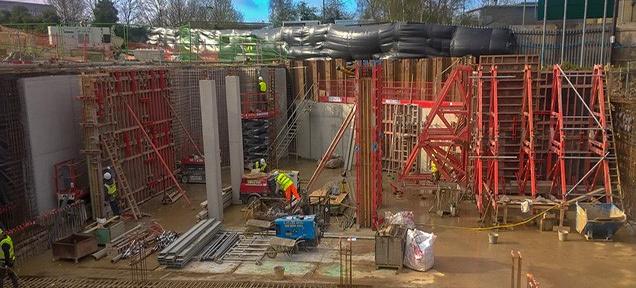
Temporary Works
Posted on October 3, 2019
What are Temporary Works?
Temporary works are the parts of a construction project needed to enable the permanent works to be built. Usually, the temporary works are removed after use, for example, access scaffolds, props, shoring, excavation support, falsework and formwork etc.; however, sometimes the temporary works are incorporated into the permanent works. For example, haul road foundations and crane or piling platforms may be used for hardstanding or road foundations.
What are Permanent Works?
Permanent works are the parts of a construction project that will be used and remain in position for a long time, say 60 years. This includes buildings and structures such as bridges, roads, retaining walls, etc. The construction of most types of permanent works will require the use of some form of temporary works.
Are Temporary Works Different to Permanent Works?
It is very important to ensure that the same degree of care and attention is given to the design and construction of temporary works as is given to the design and construction of the permanent works. Since temporary works may only be in place for a short while, there is a tendency to assume they are less important. This is incorrect since a lack of care with design, selection, assembly, etc. leaves temporary works liable to fail or collapse; and in turn, places people at risk of injury and can cause the project to be delayed.
Can I Organise the Temporary Works Myself?
The person organising the temporary works needs to be aware of the problems that can occur at each stage of the process and how to prevent these. They need to coordinate design, selection of equipment, the appointment of contractors, supervision of work, checking completion, authorisation to load and removal. Unless this is done thoroughly and systematically, problems are likely to occur. If you take this upon yourself, you must ensure each part of the process is correctly carried out.
Do I have to Appoint a Temporary Works Coordinator?
British Standard 5975 sets out one way of managing temporary works which has been found to work well on medium and large projects and uses the job title Temporary Works Coordinator (TWC). There is no legal requirement to use this job title or the British Standard recommended process, but BS5975 provides an industry consensus view on what is considered to be good practice. The legal requirement is that the party in control must ensure that work is allocated and carried out in a manner that does not create unacceptable risk of harm to workers or members of the public. On projects with relatively simple temporary works needs, you may choose not to appoint a TWC. However, you must still make sure that temporary works are properly managed to ensure safety.
Do I have to Provide Calculations for Every Temporary Works Situation?
Where the situation is small scale and straightforward, there may be a “standard solution” provided for the temporary works. These include, for example, use of a tower or system scaffold for access; design of a basic access scaffold to a standard configuration using existing data from tables; selection of a trench box to support a 2m excavation in firm, dry ground. In each of these cases, the person organising the temporary works will need to assess the ground to be sure it is suitable for the equipment involved and check that any assumptions made in the calculations for the standard solution are valid for this particular situation and the conditions on site. On a simple job, the supplier’s data will allow an experienced person to consider the necessary issues without further calculation.
Propping, using standard equipment such as screw props (‘Acrows’), needs careful consideration. To select the type, size, number and decide spacing; information is needed about the loads that will act on the props. This will include the wall above and the additional load from any other floor or roof beams etc that enter the wall above or close to the opening. Even with proprietary equipment, the support system must be worked out by a person who knows the correct methods of assessing the loads and designing the support arrangement. Failure of temporary works is often found to result from the loadings being underestimated; and in particular, where loadings from the sides are not considered.
Can all Structural Engineers Design Temporary Works?
No. Temporary works can be very sensitive to how they are used and are easily affected by other work taking place nearby. For these reasons, the temporary works designer needs temporary works training and experience.
If I Employ a Structural Engineer to Design the Temporary Works, will they be the Project Temporary Works Coordinator?
No. Coordinating the temporary works is not automatically the responsibility of the engineer carrying out the design work. Coordination is a much wider role that includes planning where and when temporary works will be needed and ensuring that they are correctly installed, used, checked and maintained. Some design engineers may be happy to be additionally contracted to act as project Temporary Works Coordinator.
Source: HSE
